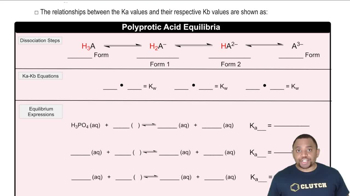Here are the essential concepts you must grasp in order to answer the question correctly.
Buffer Solutions
A buffer solution is a system that resists changes in pH upon the addition of small amounts of acid or base. It typically consists of a weak acid and its conjugate base, or a weak base and its conjugate acid. In this case, sodium benzoate acts as the conjugate base of benzoic acid, allowing the solution to maintain a relatively stable pH despite the presence of additional acids or bases.
Recommended video:
Acid-Base Equilibrium
Acid-base equilibrium involves the balance between the concentrations of acids and their conjugate bases in a solution. The dissociation of benzoic acid (C6H5COOH) into its ions establishes this equilibrium. The equilibrium constant, Ka, quantifies the strength of the acid, and is essential for calculating the concentrations of all species in the solution, including H3O+ and OH-.
Recommended video:
Triprotic Acid Equilibrium
pH Calculation
The pH of a solution is a measure of its acidity or basicity, defined as the negative logarithm of the hydrogen ion concentration (pH = -log[H3O+]). In this scenario, calculating the pH involves determining the concentration of H3O+ ions produced from the dissociation of benzoic acid in equilibrium with sodium benzoate. This requires applying the Henderson-Hasselbalch equation or the equilibrium expression for Ka.
Recommended video:
 Verified step by step guidance
Verified step by step guidance

